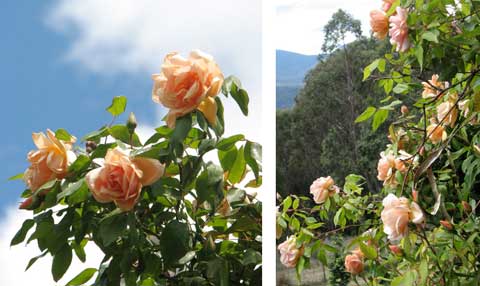Lately, with the aytpically tropical afternoon storms and heat, the grass had been growing at such a rate that I couldn’t keep up with it. I had to wait until afternoon before it was dry enough to mow and by then it would be raining again.
A bout of illness which took away any energy to seize mowing opportunities sealed my decision. I needed help.
Life is a compromise and I was about to make a big one. In essence, bugger the roses, come in and eat my grass!
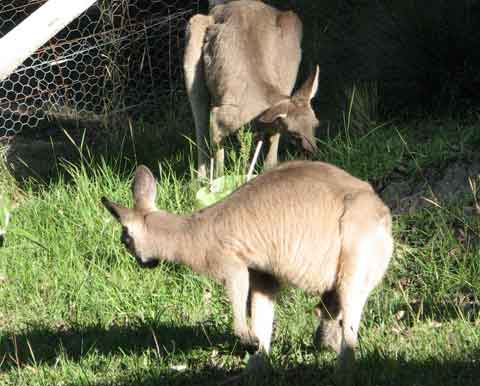 One late afternoon I opened all four gates into the house yard. You will not have your wallaby photos obscured by netting from now on.
One late afternoon I opened all four gates into the house yard. You will not have your wallaby photos obscured by netting from now on.
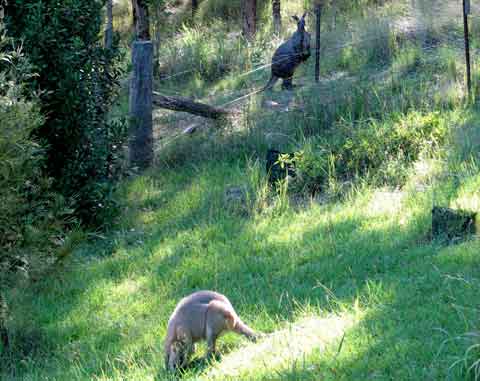 Slowly they ventured in. Wallabies first. The wallaroo looked on disapprovingly from outside the fence, where he stayed. Kangaroos are coming in too, but not close yet.
Slowly they ventured in. Wallabies first. The wallaroo looked on disapprovingly from outside the fence, where he stayed. Kangaroos are coming in too, but not close yet.
 Soon they were everywhere, and over the next few days some began to rest inside the yard, using the shade of buildings and trees during the day. Some were more calm than others, some staying still as I walked past, others bolting in panic.
Soon they were everywhere, and over the next few days some began to rest inside the yard, using the shade of buildings and trees during the day. Some were more calm than others, some staying still as I walked past, others bolting in panic.
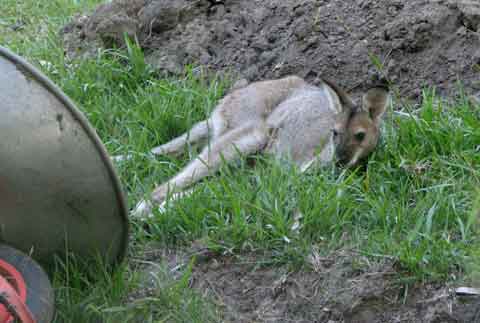 I immediately cleaned some strategic windows so I could take photos, like this laid-back wallaby. I enjoy observing the process of familiarisation. This is a new era of living here for me — and my neighbours.
I immediately cleaned some strategic windows so I could take photos, like this laid-back wallaby. I enjoy observing the process of familiarisation. This is a new era of living here for me — and my neighbours.
It was actually a great relief to have given up the struggle to maintain the yard in a manner for which I have no time – but I have to take deep breaths as I watch them stripping the roses!
Just leave the citrus alone please — I silently beg, hoping they appreciate the spirit of compromise under which I have done this.
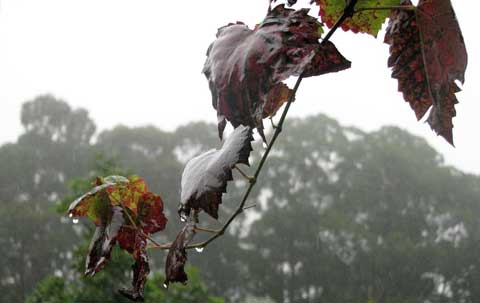 Typical of April, it’s been raining here, offering the sort of disappointingly drizzly days I associated with Saturdays when I was a child. The main splash of colour I see from my desk is the Glory Vine, the grapeless ornamental grape vine that decorates and shades my verandah.
Typical of April, it’s been raining here, offering the sort of disappointingly drizzly days I associated with Saturdays when I was a child. The main splash of colour I see from my desk is the Glory Vine, the grapeless ornamental grape vine that decorates and shades my verandah.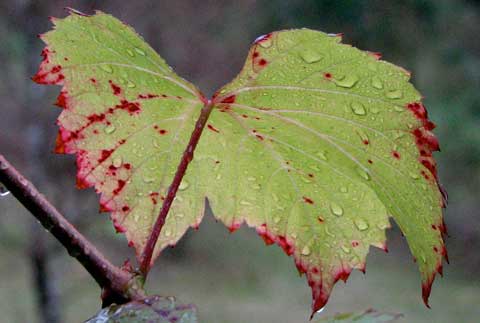 But not uniformly or in unison. Some are already deep burgundy with blackish veins, presaging their winter demise, while others stay summer green, stained at the edges with strawberry juice.
But not uniformly or in unison. Some are already deep burgundy with blackish veins, presaging their winter demise, while others stay summer green, stained at the edges with strawberry juice. In between these extremes there are pale lemons and limes, vivid rusts and scarlets, splotches and streaks like blood, a riot of colour dripping with raindrops — just for me.
In between these extremes there are pale lemons and limes, vivid rusts and scarlets, splotches and streaks like blood, a riot of colour dripping with raindrops — just for me.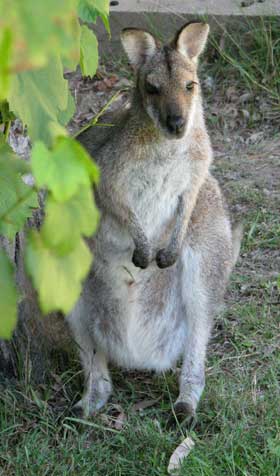
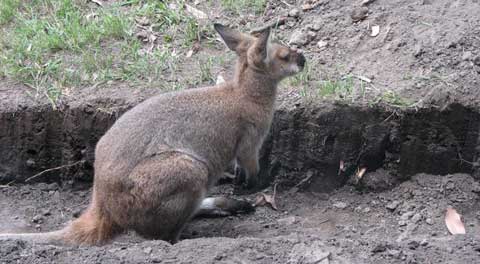 Other wallabies, like this male, choose the warm dirt and cosy sides of the excavation trench for the bathroom. The latter hasn’t progressed at all, as I am too busy, but if it makes a playground or cubby or daybed for the wallabies, that’s a plus anyway.
Other wallabies, like this male, choose the warm dirt and cosy sides of the excavation trench for the bathroom. The latter hasn’t progressed at all, as I am too busy, but if it makes a playground or cubby or daybed for the wallabies, that’s a plus anyway.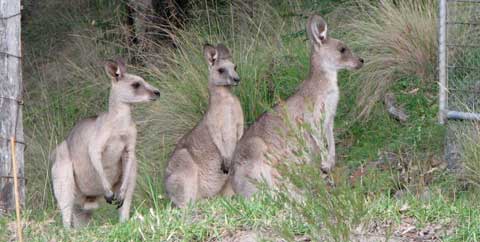 Although it is wallaby world here, the regular kangaroos are gradually getting used to me. This trio of adolescent kangaroo boys is new, and properly wary of coming into the open yard. They stood and sniffed and looked and turned their ears every which way before entering.
Although it is wallaby world here, the regular kangaroos are gradually getting used to me. This trio of adolescent kangaroo boys is new, and properly wary of coming into the open yard. They stood and sniffed and looked and turned their ears every which way before entering.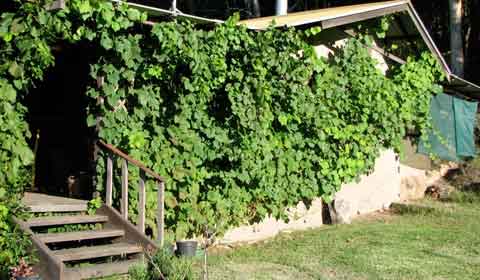 Each year the Crimson Glory Vine powers up from its woody trunk and heavily pruned short stems — and goes crazy along my western wall. I am amazed anew at its vigour.
Each year the Crimson Glory Vine powers up from its woody trunk and heavily pruned short stems — and goes crazy along my western wall. I am amazed anew at its vigour. 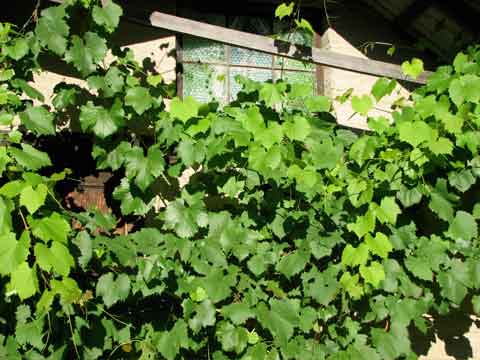 On the main western wall the greenery brings shade to the unused door and the upper fixed window; there is a leadlight window to the right of the door, but so densely shaded that it is invisible.
On the main western wall the greenery brings shade to the unused door and the upper fixed window; there is a leadlight window to the right of the door, but so densely shaded that it is invisible.  One late afternoon I opened all four gates into the house yard. You will not have your wallaby photos obscured by netting from now on.
One late afternoon I opened all four gates into the house yard. You will not have your wallaby photos obscured by netting from now on. Slowly they ventured in. Wallabies first. The wallaroo looked on disapprovingly from outside the fence, where he stayed. Kangaroos are coming in too, but not close yet.
Slowly they ventured in. Wallabies first. The wallaroo looked on disapprovingly from outside the fence, where he stayed. Kangaroos are coming in too, but not close yet. Soon they were everywhere, and over the next few days some began to rest inside the yard, using the shade of buildings and trees during the day. Some were more calm than others, some staying still as I walked past, others bolting in panic.
Soon they were everywhere, and over the next few days some began to rest inside the yard, using the shade of buildings and trees during the day. Some were more calm than others, some staying still as I walked past, others bolting in panic. I immediately cleaned some strategic windows so I could take photos, like this laid-back wallaby. I enjoy observing the process of familiarisation. This is a new era of living here for me — and my neighbours.
I immediately cleaned some strategic windows so I could take photos, like this laid-back wallaby. I enjoy observing the process of familiarisation. This is a new era of living here for me — and my neighbours.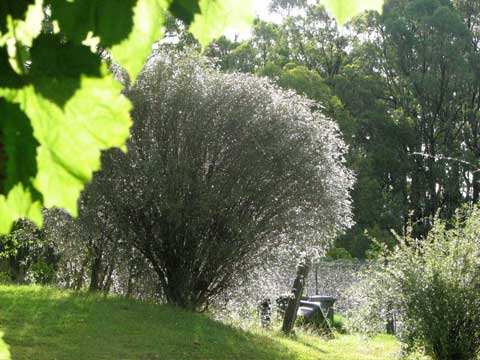 After showers, if the air is still enough, for a very brief period before the sun soaks up the raindrops — I am given diamonds.
After showers, if the air is still enough, for a very brief period before the sun soaks up the raindrops — I am given diamonds.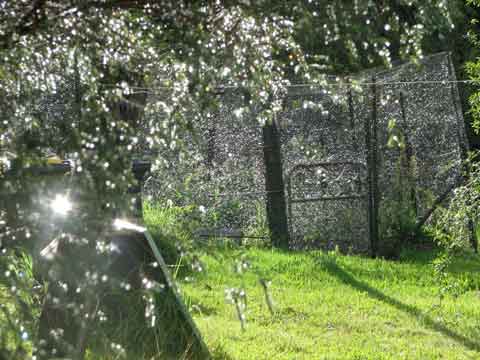 Even my hodge-podge of a vegetable garden fence is transformed; for a few minutes its strips of netting new and old, large and small, cobbled together as a snake barrier, become a thing of beauty.
Even my hodge-podge of a vegetable garden fence is transformed; for a few minutes its strips of netting new and old, large and small, cobbled together as a snake barrier, become a thing of beauty.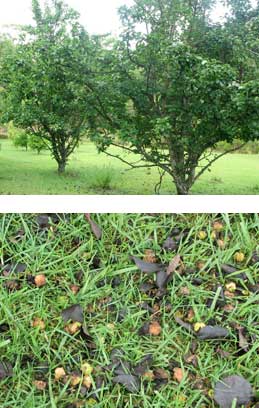 Usually the parrots and I share the crop from my two large Nashi pear trees. I get hundreds of fruit from the lower branches and they take even more hundreds from the higher ones.
Usually the parrots and I share the crop from my two large Nashi pear trees. I get hundreds of fruit from the lower branches and they take even more hundreds from the higher ones. Crimson Rosellas like this one are a major culprit but so are the red and green King Parrots, who are more elusive — or guilty.
Crimson Rosellas like this one are a major culprit but so are the red and green King Parrots, who are more elusive — or guilty.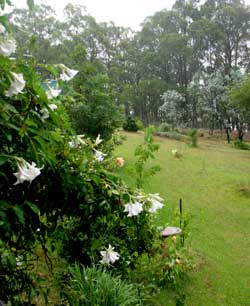 Christmas is over and it’s been raining steadily on the mountain since Christmas night. Welcome gentle rain falling from cloud cover that is allowing a pale warm light through as well –and probably putting a light charge into the solar batteries as well.
Christmas is over and it’s been raining steadily on the mountain since Christmas night. Welcome gentle rain falling from cloud cover that is allowing a pale warm light through as well –and probably putting a light charge into the solar batteries as well.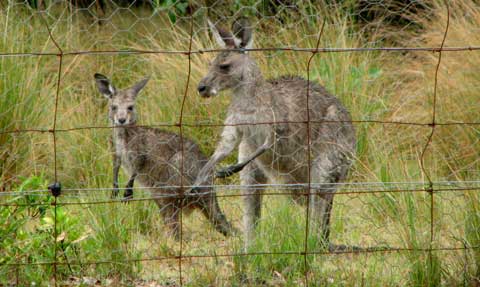 Beyond occasional emergency dashes I am confined within the cabin and the verandah’s dripping edges.
Beyond occasional emergency dashes I am confined within the cabin and the verandah’s dripping edges.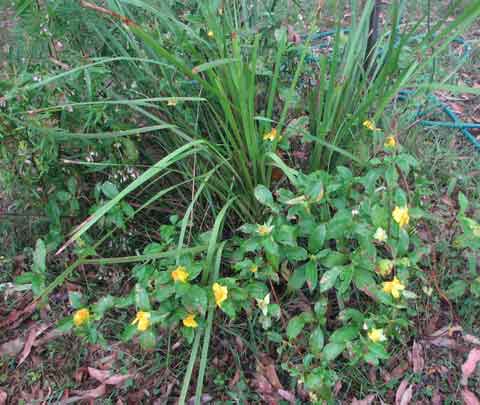 Without the need to sow or prune or feed, native plants appear, thrive and flower on my yard, where and as they choose.
Without the need to sow or prune or feed, native plants appear, thrive and flower on my yard, where and as they choose.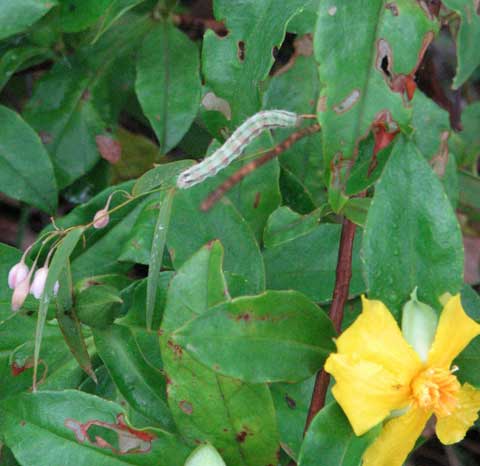 On looking closer at this little pocket of my self-sown garden, I saw it had an inhabitant – a green and pink and hairy caterpillar, which I cannot identify.
On looking closer at this little pocket of my self-sown garden, I saw it had an inhabitant – a green and pink and hairy caterpillar, which I cannot identify.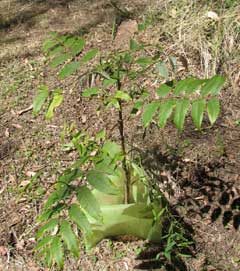 My little Red Cedar (Toona australis) trees are putting forth new leaves. These are of bronzed burgundy red, although the trees are not named for that, but for the rich red of the timber when cut.
My little Red Cedar (Toona australis) trees are putting forth new leaves. These are of bronzed burgundy red, although the trees are not named for that, but for the rich red of the timber when cut.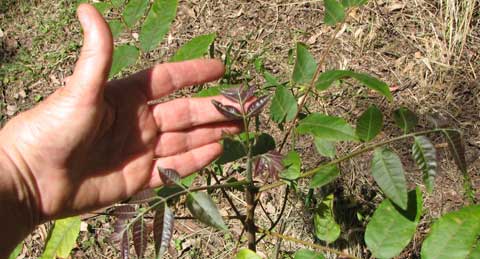
 The spectacular flower spikes of my King Orchids are long devoid of their blossoms, studded with only the tiny gold memories of where they were once attached.
The spectacular flower spikes of my King Orchids are long devoid of their blossoms, studded with only the tiny gold memories of where they were once attached.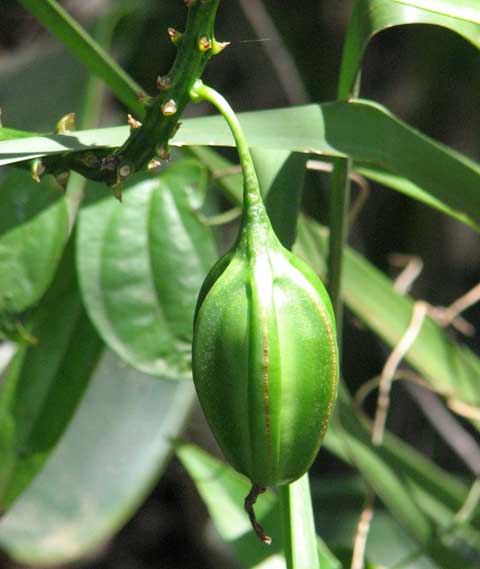 Up close they are elegantly sculpted, puffed and blown up like gooseberry paper cases, but no delicacy there; firm and fleshy, with a gold stripe down each rib, smart as the Tin Soldier’s trousers.
Up close they are elegantly sculpted, puffed and blown up like gooseberry paper cases, but no delicacy there; firm and fleshy, with a gold stripe down each rib, smart as the Tin Soldier’s trousers.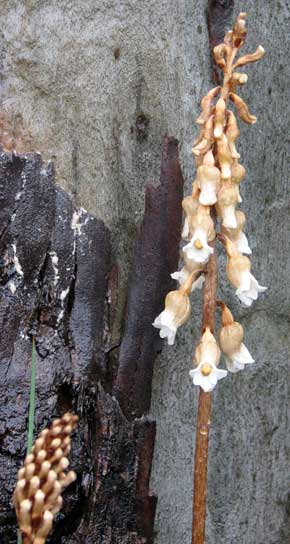 The forest here never ceases to surprise me with the apparently infinite number of plants or fungi that I have never seen before.
The forest here never ceases to surprise me with the apparently infinite number of plants or fungi that I have never seen before.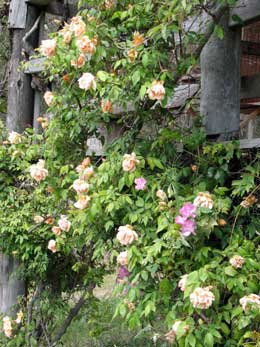 The cycle of boss tenants around here changes so often I hardly have time to adjust.
The cycle of boss tenants around here changes so often I hardly have time to adjust. 